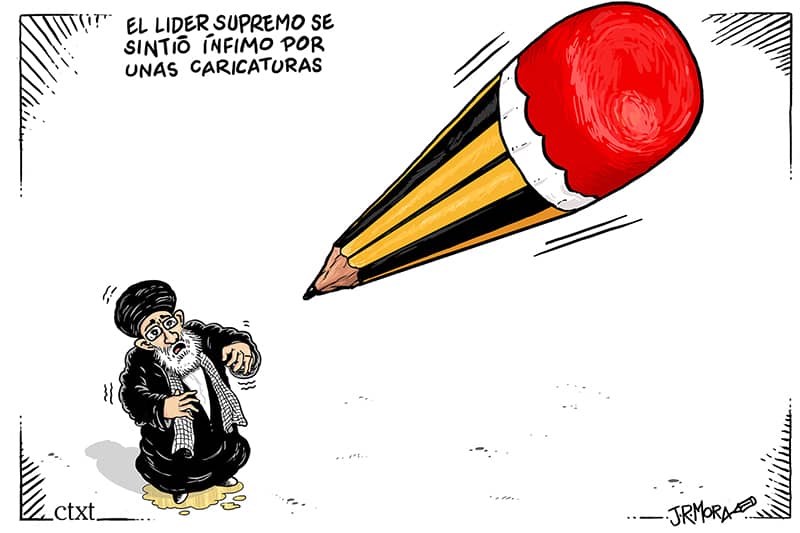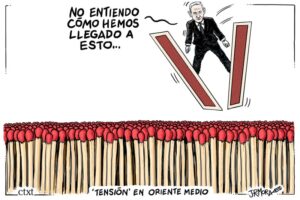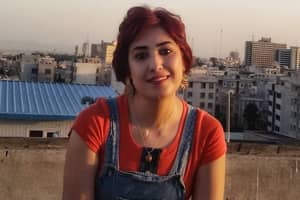
Translation: "The supreme leader was made to feel insignificant by cartoons"
The ayatollah and the cartoons. Cartoon of 07/01/2023 in CTXT
"On December 8, 2022, we launched a competition to draw caricatures of the Supreme Leader of the Islamic Republic of Iran. Our intention was to support the Iranians' struggle for freedom by ridiculing their religious leader from another era, thus relegating him to historical oblivion. A few weeks later, after receiving more than 300 cartoons (as well as thousands of threats), here is our selection of winners".
Under this text, the French satirical magazine Charlie Hebdo published on its website more than thirty cartoons with Ali Hoseini Khamenei as the main character.
The Khamenei cartoons are published in a special edition to mark the eighth anniversary of the 7 January 2015 attack. When the brothers, Chérif and Saïd Kouachi, entered the headquarters of the satirical weekly Charlie Hebdo in Paris and killed twelve people. Among them, eight were editorial staff: five cartoonists (Wolinski, Cabu, Honoré, Tignous and Charb, the publication's editor), a proofreader (Mustapha Ourrad), a psychoanalyst (Elsa Cayat) and an anti-neoliberal economist (Bernard Maris, known as "Oncle Bernard").
The jokes have infuriated the Iranian authorities, who have called the attention of the French ambassador to express their rejection of the publication of these cartoons, hoping for "compensatory action from the French government".
The EFE news agency reports that the Iranian Foreign Ministry spokesman, Naser Kanani, told the French ambassador in Tehran in a statement that "Iran in no way accepts insults against its sanctities and Islamic, religious and national values and France has no right to justify insults to the sacred values of other Muslim countries and nations under the pretext of freedom of expression".
Iran then announced the closure of the French Institute for Research in Iran(Ifri), a cultural body under the French Foreign Ministry dedicated to promoting research in the fields of archaeology and human and social sciences. Whenever they get pissed off, they always want to kill something cultural, lest they get too civilised.
According to AP, hundreds of protesters, including seminary students, shouted "Death to France" and accused French President Emmanuel Macron of insulting Iran, while urging Paris to end "animosity" towards Tehran. Police officers, some of whom appeared to be holding pictures of Iranian supreme leader Ayatollah Ali Khamenei, kept the protesters at a distance from the embassy building.
There you have them, pissed off over cartoons. I have always thought that these countries, flags, religions and symbols are not so powerful when a simple joke can make their fanatical administrators waver in their glorious might.
Charlie Hebdo argued for its action in an article published on 6 January 2023, which I reproduce in full here.
The satirical cartoon, supreme leader of freedom
Last month, Charlie Hebdo launched a competition to draw cartoons of the Supreme Leader of the Islamic Republic of Iran, Ali Khamenei. It was a way of showing our support for the Iranian men and women who risk their lives to defend their freedom against the theocracy that has oppressed them since 1979. It was also a reminder that the reasons why Charlie's cartoonists and editors were killed eight years ago are, sadly, still relevant today. Those who refuse to submit to religious dictates risk paying with their lives. What would Charb, Cabu, Bernard Maris, Wolinski, Tignous, Mustapha Ourrad, Honoré and Elsa Cayat think today when they see what is happening in Iran? No one can say, but we can guess. Eight years on, we have not yet heard the last of religious intolerance. It continues its grim work, regardless of international protests or respect for the most basic human rights.
In a way, the cartoons of the Supreme Leader that have come down to us are an extension of what the murdered Charlie cartoonists have always denounced. In 2000, Honoré wrote a column in support of the Iranian cartoonist Nik Ahang-Kosar, threatened with a year in prison and 74 lashes for having depicted Ayatollah Mohammad-Taghi Mesbah-Yazbi as a crocodile. At the time, a score of reformist Iranian newspapers had demanded that this dignitary be sued for slander. That was a long time ago..
Even before that, in 1993, Tehran launched a cartoon competition in which cartoonists were asked to draw the author of The Satanic Verses, Salman Rushdie, to "describe the real conspiracy behind the blasphemous novel". The winner would receive 160 gold coins. In response, Charlie Hebdo published 20 satirical cartoons about the Islamic Republic of Iran. In the end, without the contest launched by the Iranian ayatollahs who wanted to ridicule Rushdie, it might never have occurred to us, 13 years later, to publish the cartoons of Mohammed, nor today those of the current Iranian Supreme Leader. For that, at least, we can thank them.
We received caricatures from all over the world, which proves, for those who still doubted it, the universal dimension of caricature and people's attachment to freedom in the face of religious arbitrariness. We have selected the most successful, original and effective of the more than 300 drawings sent to us. In any case, they all have the merit of having challenged the authority that claims to be Leader, supposedly Supreme, as well as his cohort of servants and hired assassins. Obviously, there is no prize to be won, because attributing a first, second and third place would in fact devalue the other draws. And anyway, what reward would be worth having the courage to say "no" to religious tyrants? However, there is one reward that no one can buy or give, plain and simple because it is priceless, and that is freedom.
Related:







